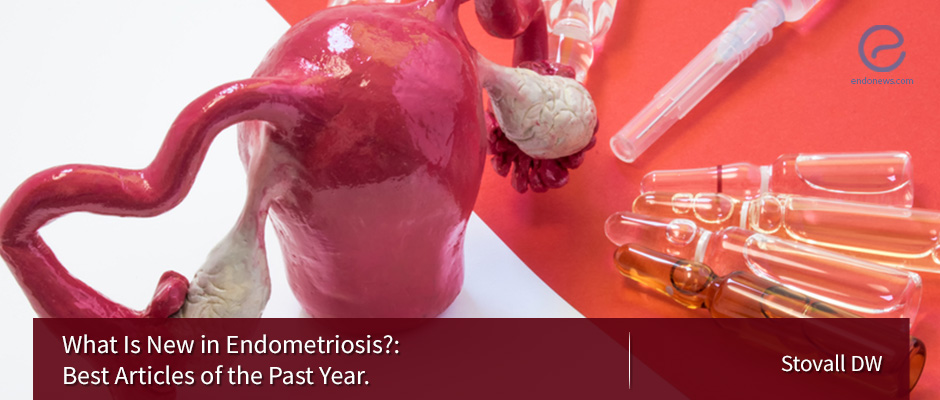Best endometriosis articles of the past year.
Nov 9, 2018
Bottom-line messages from four recent important endometriosis papers.
Key Points
Highlights:
- The bottom lines of four different topics about endometriosis (treatment, miscarriage risk factors, pregnancy outcomes, and economic costs) are described.
Importance:
- Treatment methods of pain, the risk of miscarriages, pregnancy outcomes and cost related to endometriosis are still a problem for healthcare providers and a deep concern for the patients.
What's done here:
- Dr. Stowall from Methodist Hospital in Dallas pointed out four important publications of last year to specify the most recent inventions in endometriosis.
Key Results:
- The takeaway remarks of four separate research are as below:
- Elagolix treatment for dysmenorrhea and nonmenstrual pelvic pain either 150 or 400 mg/d dose resulted in significant reductions in both pain types, being more effective for dysmenorrhea; but was associated with significant side effects including hot flushes, headaches, insomnia, amenorrhea, mood swings, night sweats, arthralgia.
- Miscarriages in pregnancies of endometriosis patients are remarkable, but interestingly, when only women who were not known to have infertility were compared with women in the control group, the difference in miscarriage rates was not significant. Importantly, the women with earlier stages of endometriosis were affected more.
- A large retrospective study database of pregnancies with endometriosis indicated that the pregnant women affected by endometriosis have different socio-demographic characteristics and there is an independent rise of the placenta previa.
- There is still a need for cost-effective methods for the treatment of endometriotic patients regarding overall data in the US.
Lay Summary
Dr.Stowall, from the Department of Obstetrics and Gynecology of Methodist Hospital, Dallas, Texas, USA penned this letter and recently published it in the Journal of Obstetrics and Gynecology to show his remarks of importance on four best publications of the last year.
The first summary was evaluating the paper by Taylor et al. published in NEJM, concerning two multicenter, placebo-controlled, randomized, double-blind trials; both randomized more than 800 patients to assess the effects of 150- and a 400-mg/day doses of Elagolix for the endometriosis-related dysmenorrhea or nonmenstrual pain. The bottom line is that the Elagolix treatment for both doses resulted in significant reductions in both pain types, being more effective for dysmenorrhea; however, it was associated with significant side effects such as hot flushes, headaches, insomnia, amenorrhea, mood swings, night sweats, arthralgia, bone mineral density loss.
Miscarriage in pregnancy of endometriotic patients was the topic of the second research where Schwartz et al. studied on surgically staged 240 pregnant women with endometriosis. Their control group was 268 pregnant women who had any surgical or clinical symptoms consisting of endometriosis. The statistical results showed an increased risk of miscarriage in the endometriotic pregnant group. However, when only women with endometriosis who did not have infertility were compared with women in the control group, the difference in miscarriage rates was not significant. Moreover, when they evaluated the stages of the endometriotic pregnants, they found higher miscarriage rate in the women with early stage (stage I-II) endometriosis.
Adverse pregnancy outcomes of surgically diagnosed endometriotic women who conceived were the topic of the third article of interest. Chen et al. worked on a retrospective cohort study of 469 endometriotic and 51.733 healthy pregnant women including all single births occurred over a 10 past year in a tertiary center in Canada. The important finding was that the pregnant women affected by endometriosis showed different socio-demographic characteristics. Furthermore, among all kind of fetal and maternal outcome complications, they found placenta previa to be the only significantly increased risk, with a risk ratio of 1:2.54.
The final study was connected to Real World Evaluation of direct and indirect economic burden among endometriotic patients in the United States. Soliman et al. reported a retrospective and an age-matched cohort study using commercial database throughout the United States to access the cost of endometriosis disease to the patients. The finding was that 62% of endometriosis treatment cost occurred in the first three months after the diagnosis. Short term and long term disabilities are also significantly higher in endometriotic patients when compared with the controls.
Research Source: https://www.ncbi.nlm.nih.gov/pubmed/30211765
treatment of endometriosis miscarriage oral GnRh antagonist dysmenorrhea pelvic pain economic cost of treatment endometriosis placenta previa pregnancy outcome bottom line.

